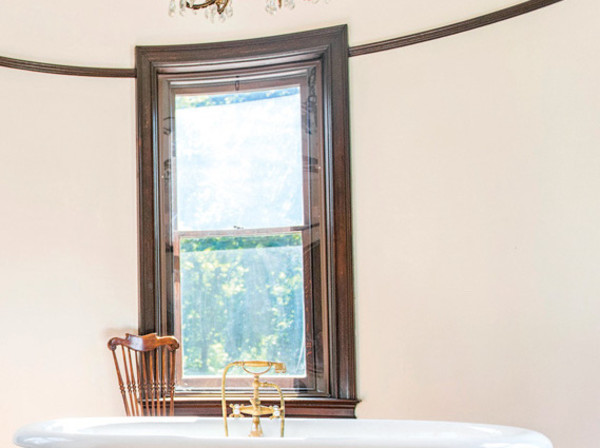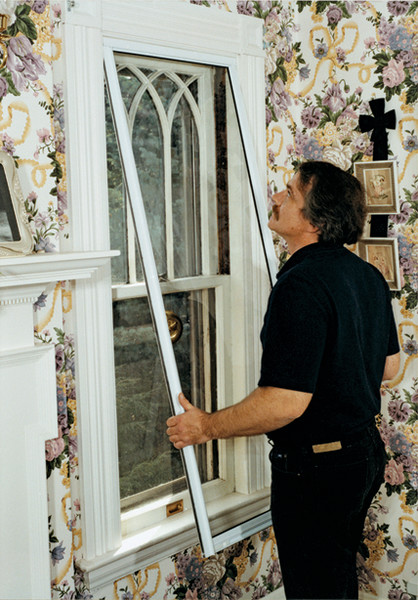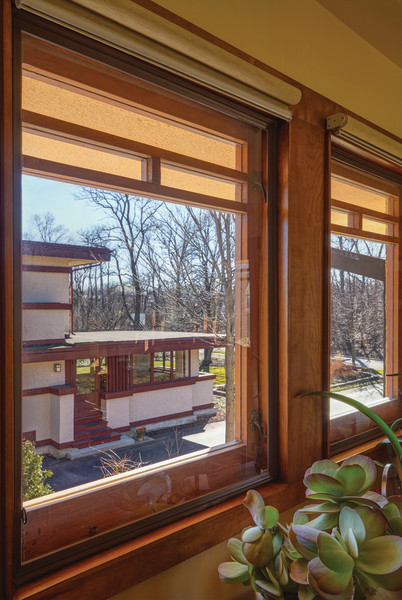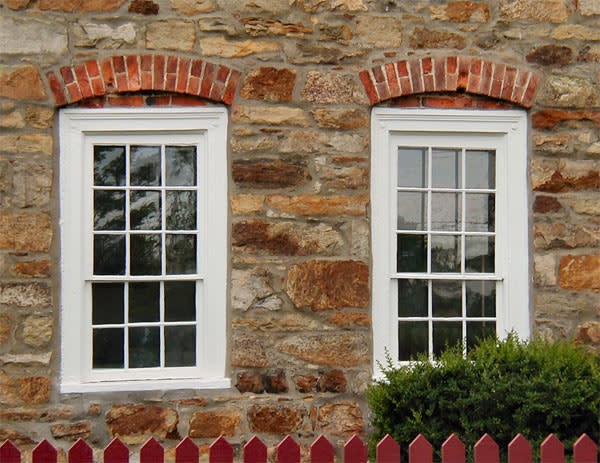The owners of the mid-century house chose Indow interior storm windows to make their existing, outward-opening casements more energy efficient. If your primary goal is to reduce energy loss, an interior storm is a smart choice, especially if the old sashes are in good shape.
Actually, “storm window” is a misnomer for these interior retrofits: while they protect the prime window from condensation and add R-value, they don’t offer exterior protection against the elements. Sometimes called invisible storms or energy panels, they typically consist of a single panel of glass or clear acrylic held in place, inside the interior window frame casing, by magnetic force or by a compression seal (similar to a gasket). Interior storms usually cost less than exterior storm panels. They can be sized to fit any window, even the non-standard ones found on older homes.

An interior storm window from Indow stops drafts in the bathroom.
With studies backing the claim, there’s no question that it’s cheaper, easier, and more energy efficient to install interior storm windows than to replace original sash. An interior panel offers performance similar to a high-end replacement window. Sam Pardue at Indow reports that their inserts start at $24 per square foot. A wood replacement window runs $71–109 per square foot, vinyl $65–87. Thus an interior panel costing $250–400 may be as effective as an $800 double-glazed replacement window—and, of course, the insert requires no construction crew and doesn’t change the look of the building.
The Difference Between Interior and Exterior Storm Windows
Interior storm windows fit inside existing window openings and often more economical than adding exterior storm windows, which are installed on the exterior side of your windows.
According to two independent studies by the U.S. Dept. of Energy and Portland State University, installing a well-fitted interior window can lower heating and cooling bills by 20 percent or even more. Sam Pardue explains that such performance is partly a result of occupants feeling so much more comfortable (due to the warmer glazing and fewer drafts), they lowered the thermostat after inserts were installed. David Degling at Innerglass points out that exterior storms must be ventilated (with weep holes) to get rid of condensation from warm inside air that has already escaped. An interior storm doesn’t allow indoor air flow to get to the primary window. Condensation is greatly reduced.

Here’s an appropriate interior storm window, by Innerglass Window Systems.
Courtesy of Innerglass Window Systems
Interior storms are recommended for soundproofing, as well. Even standard glazing will provide good sound insulation, and some companies offer an acoustic-grade window for impressive noise reduction. Low-E coatings add even more R-value by turning glazing into a heat mirror. Easily removed, interior storms by reputable companies are approved by most building codes for egress (escape in an emergency) and for ingress by firefighters.
Acrylic or Glass?
Various companies offer glass, acrylic (e.g., Plexiglas), or polycarbonate (e.g., Lexan) glazing for storm windows. Glass is heavy and cold: “We use acrylic glazing for interior windows not exposed to the elements,” says a distributor for Climate Seal; “acrylic has higher insulating properties, and is so much lighter yet stronger than glass of equal thickness.”
Polycarbonate generally is reserved for exterior window panels that need to be unbreakable for security reasons. Polycarbonate is the material that has a reputation for yellowing after UV exposure. Modern acrylics don’t yellow, but can become hazy if scratched or cleaned too aggressively. Acrylic should be cleaned with a product like Brillianize Cleaner and a soft cloth like Wypall, not with paper towels.
Indow suggests that customers remove and reinstall inserts a couple of times a year to reseat them; panels reduce air conditioning load so may be used year-round. The company recommends storing them flat, no more than three windows in a stack, and using their clear storage sleeves to protect against scratches.
Storm Window Companies
These companies are recognized for the efficacy of their retrofit interior glazing suitable for historic homes:
Allied Window
Allied “invisible storm windows” are custom-made for interior or exterior use. All glazing options are available (glass, tempered, tinted, acrylic, low-E, polycarbonate). The magnetic panel is inserted into an upper channel installed with screws, then pressed into jamb stops. One version offers a vertical-opening operating bottom panel for ventilation; another has sliding panels for use with steel casements. The company has a line suitable for smaller windows with limited sill depth. Options include custom colors, screens, and special shapes and muntin configurations. alliedwindow.com

An example of Indow interior storm panels.
Courtesy of Indow
Indow
Indow interior storm panels are routinely made to precisely fit non-standard and out-of-square windows; arched and rounded windows can be made. (An unobstructed flat edge within the frame with a depth of at least 5⁄8″ must run the perimeter.) Indow panels are acrylic and edged in silicone compression tubing that creates a spring force to hold inserts in place without a mounting bracket. Integral safety straps are available for high-wind installations. The acoustic grade cuts outside noise by more than 70 percent; shade grade performs like low-E glass and is recommended for hot climates; their museum grade blocks UV light; privacy grade is translucent to admit light while creating privacy. indowwindows.com
Climate Seal
Climate Seal has long been known for commercial and historic-preservation work, and now serves residential customers. The system uses magnetic attachment with mouldings and a bellows design to eliminate clips and screws. Four lines: Thermal (1⁄8″ acrylic) is for temperature control and rapid payback. Acoustic (¼” acrylic with special weatherstrip) drastically reduces sound infiltration. Preservation Series minimizes the aesthetic imprint and provides museum-level UV filtering. Pro offers the advantages of Thermal with abrasion-resistant acrylic. One offering is a two-panel self-storing window with an operable lower insert. climateseal.com

It’s hard to detect interior storm panels from the exterior.
Courtesy of Innerglass
Innerglass Window Systems
Innerglass makes interior panels, tightly compression-fitted, which act as a vapor barrier. A header channel fits inside the top of the window frame; compression sides are squeezed into the channel, then pressed top to bottom. Blocking pins are inserted into small holes drilled on either side of the window front. Glass panels are framed in vinyl. The company also makes double-hung interior storms that move in narrow tracks on three sides; sashes are easily removable, and match the meeting rail height of the existing window. They also make sliding storms for use over several steel casements in one opening. stormwindows.com
Mon-Ray
Mon-Ray has, in addition to various exterior storm window lines, their 500 Series of aluminum storms which can be used for interior applications. They come in a variety of painted and anodized finishes. Various configurations include removable panels, horizontal sliders, and double-hung windows. The panel is inserted in a screw-mounted channel. They can do custom radius shapes and miter angles. And screens are available. monray.com







